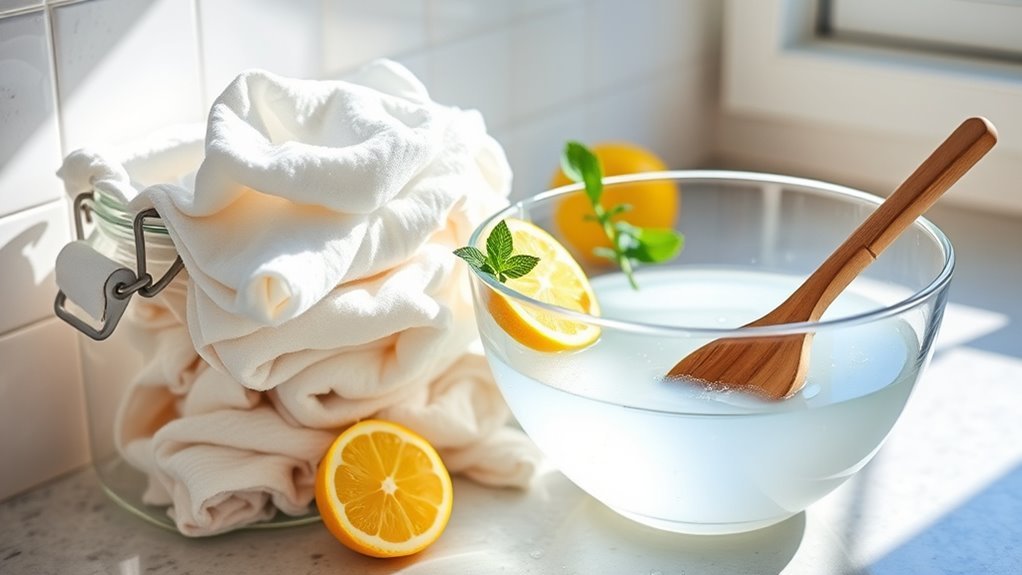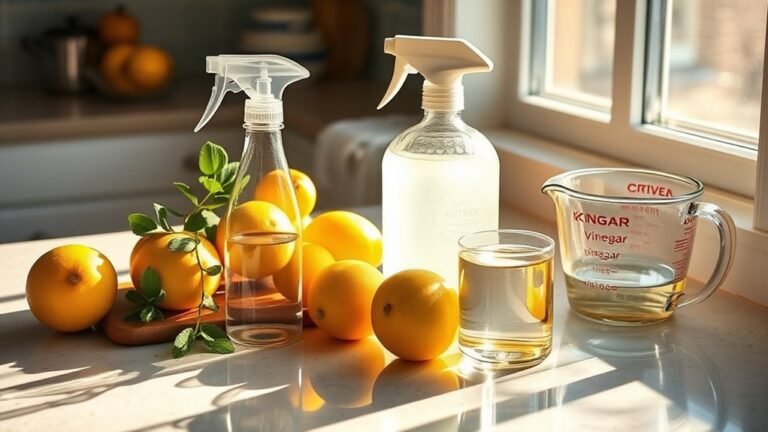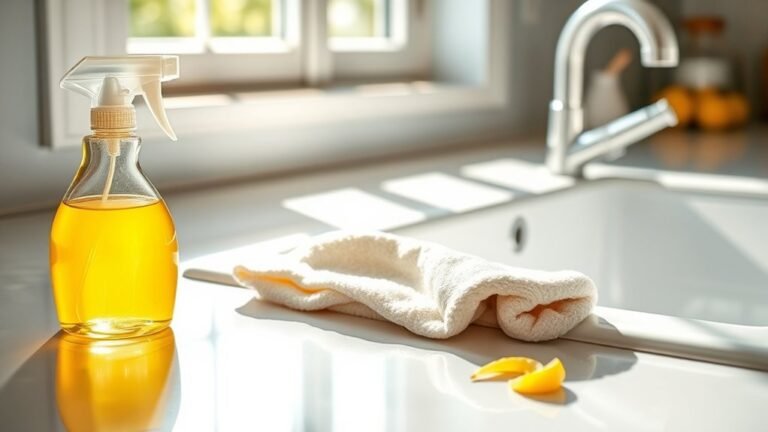How to Make Reusable Cleaning Wipes for a Zero-Waste Home
You can make reusable cleaning wipes by cutting cotton or bamboo fabric into 6×6 inch squares, sewing edges with a small seam allowance, then turning them right side out and topstitching for durability. Mix a natural cleaning solution with vinegar, water, and essential oils to spray on your wipes. Store them in airtight containers to keep fresh and use gentle detergents when washing. Keep wipes handy for easy cleaning and discover simple ways to create your eco-friendly, zero-waste cleaning routine.
Benefits of Using Reusable Cleaning Wipes

Using reusable cleaning wipes offers several clear benefits that can make your cleaning routine easier and more eco-friendly. When you switch to reusable wipes, you reduce waste considerably, cutting down on the environmental impact caused by disposable alternatives. This simple change lets you take control over your household’s footprint, aligning your actions with a lifestyle that values freedom from excess waste. Plus, you’ll notice cost savings over time since you won’t be constantly buying disposable wipes. Investing once in reusable wipes means fewer trips to the store and less money spent on single-use products. You get the freedom to clean effectively while protecting the planet and your wallet, making reusable wipes a smart and sustainable choice for anyone ready to embrace a zero-waste home.
Materials Needed for DIY Cleaning Wipes
To make your own DIY cleaning wipes, you’ll need just a few essential materials that are easy to find. Start with choosing the right fabric types—cotton flannel, microfiber, or old t-shirts work great because they’re durable and washable. You’ll also want scissors or a rotary cutter to cut your fabric into practical wipe sizes, typically around 6×6 or 8×8 inches, depending on your cleaning needs. A sewing machine or needle and thread will help you finish the edges to prevent fraying. Additionally, have a spray bottle handy for your cleaning solution once your wipes are ready. With these simple materials, you’re set to create reusable wipes that give you freedom from waste and endless cleaning power.
Choosing the Right Fabric for Your Wipes

When selecting fabric for your reusable cleaning wipes, you’ll want materials that balance absorbency, durability, and ease of washing. Cotton fabric is a fantastic choice—it’s soft, highly absorbent, and holds up well over repeated use and washes. Plus, it’s widely available and affordable, giving you freedom to customize without breaking the bank. Bamboo fabric offers a great alternative if you’re after something eco-friendly and naturally antimicrobial. It’s super soft and resists odors, making your wipes last longer between washes. Both cotton and bamboo fabrics dry quickly, which helps prevent mildew and keeps your cleaning routine hassle-free. By choosing either of these fabrics, you’re setting yourself up for a zero-waste lifestyle that’s practical, effective, and liberating.
Step-by-Step Guide to Making Reusable Wipes
Before you plunge into making your reusable wipes, gather all the materials you’ll need, including your chosen fabric, scissors, and thread or a sewing machine. Start by cutting your fabric into squares—6×6 inches works well. Next, fold each square in half, then sew around the edges with a small seam allowance, leaving a tiny gap to turn it right side out. After turning, topstitch around the edges to secure the gap and add durability. This simple process reduces waste and lets you take control of your cleaning routine. By making your own wipes, you slash your environmental impact and enjoy significant cost savings compared to disposable wipes. Embrace this DIY freedom—it’s a small effort for a big change in your zero-waste lifestyle.
Creating an Effective Cleaning Solution

To make your reusable wipes work well, you’ll want to pick safe ingredients that clean effectively without harsh chemicals. Getting the right mix is key—too much or too little of any component can affect performance. Plus, knowing how to store and use your solution properly will keep your wipes fresh and ready for action.
Choosing Safe Ingredients
How do you guarantee your reusable cleaning wipes are both effective and safe? Start by choosing safe alternatives that won’t harm you, your home, or the planet. Opt for natural ingredients like vinegar, baking soda, and essential oils—these pack a powerful punch against dirt and germs without toxic chemicals. You want ingredients that’re gentle on surfaces and skin, yet tough on grime. Avoid synthetic fragrances and harsh detergents that can cause irritation or environmental damage. Embracing natural ingredients gives you freedom from harmful additives while keeping your cleaning routine simple and trustworthy. Remember, your goal is a solution that’s safe for everyone in your home and aligns with your zero-waste lifestyle. That balance guarantees your homemade wipes are as effective as they are eco-friendly.
Mixing Proper Ratios
Getting the right balance between ingredients is key when mixing your cleaning solution for reusable wipes. You want to guarantee proper dilution so the solution cleans effectively without wasting product or causing damage. Start by following recommended ingredient ratios—usually one part concentrated cleaner to ten parts water is a solid baseline. Adjust slightly depending on your cleaning needs, but avoid overly strong mixes that can leave residue or degrade fabric. Keep it simple: a few drops of essential oil, a splash of vinegar, and water often do the trick. By mastering these proper dilution and ingredient ratios, you gain control over your cleaning power and reduce waste, freeing yourself from harsh chemicals and single-use products.
Storage and Usage Tips
Three key factors will help you store and use your reusable cleaning wipes effectively: keeping them moist, preventing contamination, and knowing when to refresh the solution. Choosing the right storage options and mastering usage techniques guarantees your wipes stay ready whenever you need them.
- Store wipes in an airtight container or glass jar to maintain moisture and avoid drying out.
- Use clean hands or tongs when grabbing wipes to prevent spreading germs or dirt back into the solution.
- Refresh your cleaning solution every 1-2 weeks to keep it effective and fresh, especially if you notice any odor or discoloration.
How to Store and Use Your Reusable Wipes
Although reusable wipes are designed for multiple uses, proper storage and handling are key to keeping them effective and fresh. You’ll want to choose storing solutions that allow your wipes to breathe—think mesh bags or containers with ventilation—to prevent moisture buildup and odors. Avoid airtight containers unless the wipes are fully dry. When it comes to usage techniques, always keep a dedicated spot for your wipes, so they’re easy to grab when you need them. Use them gently on surfaces to extend their life, and rinse or soak them promptly after use to prevent stains or grime from setting in. With these simple habits, you’ll enjoy the freedom of eco-friendly cleaning without the hassle of constantly replacing wipes.
Tips for Cleaning and Maintaining Your Wipes
To keep your reusable cleaning wipes in top shape, it’s important to follow proper washing instructions and use the best drying methods. How you store them afterward can also affect their lifespan. Let’s look at simple steps to maintain their effectiveness and durability.
Washing Instructions
When you want your reusable cleaning wipes to last, proper washing is key. Mastering washing techniques and fabric care lets you keep your wipes fresh without hassle. Avoid harsh chemicals and high heat that can wear down fibers. Instead, follow these simple steps:
- Use mild detergent and warm water to preserve fabric integrity.
- Wash wipes separately or with similar fabrics to prevent lint transfer.
- Skip fabric softeners, as they reduce absorbency and effectiveness.
Drying Best Practices
After washing your reusable cleaning wipes properly, how you dry them impacts their longevity and performance just as much. To keep your wipes in top shape, opt for gentle drying techniques. Air drying is your best bet—it preserves fabric integrity and prevents shrinkage or damage that heat can cause. Hang your wipes in a well-ventilated space, preferably outdoors or near an open window, to speed up drying without harsh effects. If you’re in a hurry, use a low-heat setting on your dryer, but avoid high temperatures that can degrade fibers over time. By embracing these drying techniques, you maintain your wipes’ absorbency and strength, giving you the freedom to clean effectively while minimizing waste.
Storage and Longevity
Although proper washing and drying are essential, how you store your reusable cleaning wipes plays an equally important role in extending their lifespan. Choosing the right storage containers keeps your wipes fresh and ready to use, preventing mildew and odors. Here are some longevity tips to help you maintain your wipes effortlessly:
- Use airtight storage containers to keep moisture out and preserve cleanliness.
- Store wipes in a cool, dry place away from direct sunlight to prevent fabric degradation.
- Rotate your wipes regularly to avoid overusing certain ones, ensuring even wear.
Eco-Friendly Alternatives to Disposable Cleaning Products
Since disposable cleaning products often end up in landfills, switching to eco-friendly alternatives can make a big difference for the environment. You don’t have to sacrifice convenience to live more sustainably. Look for biodegradable products that break down naturally without harming ecosystems. Choosing sustainable brands committed to minimizing waste and using non-toxic ingredients guarantees your cleaning routine supports the planet. These options often come in refillable containers or compostable packaging, reducing plastic pollution. By adopting these alternatives, you’ll feel freer from the endless cycle of buying and tossing. Plus, you’ll be empowering a lifestyle that respects nature’s limits and promotes lasting change. Making these thoughtful swaps is a simple step toward a cleaner home and a cleaner earth.
Incorporating Reusable Wipes Into Your Cleaning Routine
When you switch to reusable wipes, you’re cutting down on waste without giving up ease or effectiveness. Integrating them into your cleaning routine is simple and liberating. You’ll enjoy the freedom of ditching disposables while keeping your space spotless. Start by keeping a stash of wipes in key areas—kitchen, bathroom, and your cleaning caddy. After use, toss them in the laundry to keep them fresh and ready. Embrace these eco friendly practices to make cleaning sustainable and hassle-free:
- Use gentle, natural cleaning solutions with your wipes for a green clean.
- Designate specific wipes for different tasks to avoid cross-contamination.
- Store clean wipes in a damp container to keep them moist and ready.
This approach keeps your home fresh and your footprint light, all while simplifying your cleaning routine.
Frequently Asked Questions
Can Reusable Cleaning Wipes Be Used for Disinfecting Surfaces?
You can definitely use reusable cleaning wipes for disinfecting surfaces, but you’ll want to soak them in proper disinfecting solutions to guarantee surface safety. Just make sure the solution you choose is effective against germs and safe for the material of your wipes. This way, you maintain freedom from waste without compromising cleanliness or your health. Remember to wash your wipes thoroughly after use to keep them fresh and ready for the next round.
How Long Do Reusable Wipes Typically Last Before Replacement?
You can expect reusable wipes to last several months, sometimes even over a year, depending on fabric durability and how often you use them. Choosing high-quality, sturdy fabrics extends their lifetime expectations, letting you enjoy freedom from constant replacements. Just wash and dry them properly to keep them in good shape. When you notice fraying or reduced effectiveness, it’s time for a swap, but until then, they’re a reliable, eco-friendly choice.
Are Reusable Cleaning Wipes Safe for Use on Electronics?
You might think wiping your electronics with any cloth is risky, but reusable cleaning wipes, especially microfiber cloths, offer a surprising balance of safety and effectiveness. When used gently and without harsh chemicals, they protect your electronic device safety while efficiently removing dust and smudges. Just avoid excess moisture to keep freedom from damage. Embrace that freedom—clean your screens confidently with these eco-friendly wipes that respect both your gadgets and your lifestyle.
Can I Customize the Scent of the Cleaning Solution?
Absolutely, you can customize the scent of your cleaning solution to match your vibe. There are plenty of scent options out there, especially when you use essential oils. You’re free to mix and match oils like lavender, lemon, or eucalyptus to create a fragrance that energizes or relaxes you. It’s all about personalizing your space and cleaning routine, so go ahead and experiment until you find your perfect scent combo!
Is It Possible to Compost Used Reusable Cleaning Wipes?
Imagine your used wipes as fallen leaves ready to nourish the earth. Whether you can compost them depends on the materials—natural fibers break down gracefully, while synthetic blends resist wipe degradation. You want freedom from waste, so choose wipes made from composting materials like cotton or bamboo. Avoid plastic threads or heavy chemicals, and your wipes can return to the soil, closing the loop and freeing you from landfill chains.






